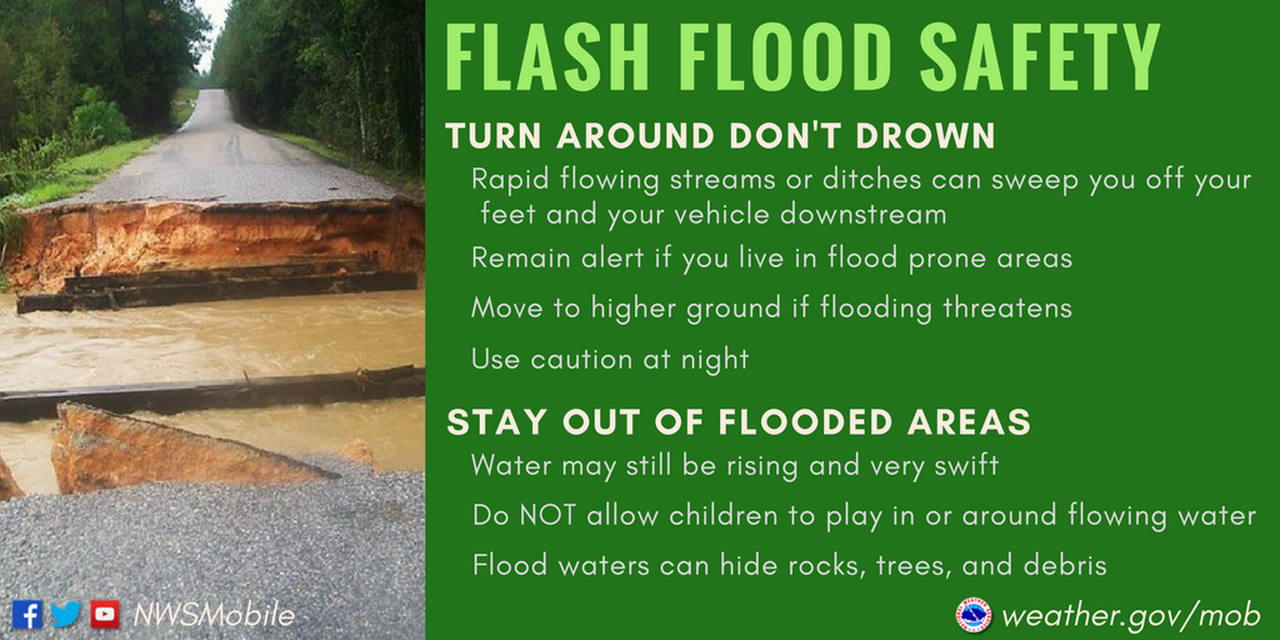Flash Flood Emergency: What To Know And How To Stay Safe

Table of Contents
Understanding Flash Flood Risks
Flash floods are unpredictable and dangerous events, often triggered by intense rainfall over a short period. Several factors contribute to the risk of flash floods. Understanding these risk factors is the first step in protecting yourself. Key factors include: heavy rainfall exceeding the ground's absorption capacity, overflowing rivers and streams, dam or levee failures, and rapid snowmelt in mountainous regions.
Areas particularly vulnerable to flash floods include:
- Mountainous regions: Steep slopes channel water rapidly into valleys and low-lying areas.
- Areas with poor drainage: Insufficient drainage systems lead to water accumulation and rapid flooding.
- Regions near rivers and streams: These areas are directly impacted by overflowing waterways during heavy rainfall.
- Urban areas with extensive paved surfaces: Pavement prevents water absorption, increasing runoff and flood risk.
Identifying your local flood risk is paramount. Understanding the typical weather patterns that precede flash floods in your region, such as heavy thunderstorms or rapid snowmelt, is equally important. Recognizing the signs of an impending flash flood—rapidly rising water levels, strong currents, and unusual water sounds—can provide precious time to take action.
Preparing for a Flash Flood Emergency
Proactive preparedness is crucial when it comes to flash flood safety. Creating a comprehensive emergency plan, assembling a flash flood emergency kit, and familiarizing yourself with evacuation routes are essential steps. Investing in flood insurance can also significantly mitigate potential financial losses.
Here's how to prepare:
- Develop a family communication plan: Establish a designated meeting point and communication methods in case family members are separated during a flash flood.
- Prepare an emergency kit: Include essential supplies such as bottled water, non-perishable food, a first-aid kit, flashlight with extra batteries, a battery-powered radio, medications, important documents (in waterproof bags), and extra clothing.
- Identify multiple evacuation routes: Know several escape routes from your home and workplace, considering potential road closures.
- Consider purchasing flood insurance: This crucial step can help alleviate the financial burden of flood damage.
Responding to a Flash Flood Warning
When a flash flood warning is issued, immediate action is critical. Your safety is the top priority. Never underestimate the power of floodwaters; even a seemingly shallow stream can become a raging torrent.
Here's what to do:
- Move to higher ground immediately: This is the most crucial step; the higher the ground, the safer you are.
- Never attempt to drive through floodwaters: Even a few inches of water can sweep away a vehicle. Turn around, don't drown.
- Stay away from floodwaters: Floodwaters often contain hazardous materials, including sewage, chemicals, and debris.
- Follow evacuation orders promptly: Obey instructions from emergency officials and evacuate immediately.
- Seek shelter in a sturdy building: If evacuation is impossible, move to the highest level of a strong building and stay away from windows.
Post-Flash Flood Actions
After a flash flood, safety remains a critical concern. Assessing damage, ensuring safe cleanup procedures, and reporting damages are vital post-flood actions.
Remember to:
- Wait for authorities to declare the area safe before returning: Check for downed power lines, damaged structures, and other hazards.
- Wear protective gear (boots, gloves) during cleanup: Floodwaters can be contaminated, so protect yourself from harmful substances.
- Report damages to your insurance company and local authorities: This helps in assessing the extent of damage and initiating necessary aid.
- Be aware of potential hazards such as downed power lines and contaminated water: Exercise extreme caution during the cleanup process.
Conclusion
Flash floods are dangerous and unpredictable events. The power of a flash flood is immense and can be life-threatening. Proper preparation, understanding of risks, and swift response are absolutely crucial for survival. Don't underestimate the potential for severe damage and loss of life.
Stay informed about flash flood risks in your area and develop a comprehensive flash flood emergency plan today. Don't wait for a flash flood warning; prepare for a flash flood emergency now to protect yourself and your family. Learn more about flash flood safety and preparedness by visiting [link to relevant resource - e.g., your local emergency management agency website].

Featured Posts
-
 Indian Wells 2024 Draper Secures Historic Masters 1000 Victory
May 25, 2025
Indian Wells 2024 Draper Secures Historic Masters 1000 Victory
May 25, 2025 -
 Stock Market Valuation Concerns Bof As Insights And Recommendations
May 25, 2025
Stock Market Valuation Concerns Bof As Insights And Recommendations
May 25, 2025 -
 New York Times Connections Hints And Answers March 18 2025 646
May 25, 2025
New York Times Connections Hints And Answers March 18 2025 646
May 25, 2025 -
 The National Enquirer And Mia Farrows Comeback Ronan Farrows Involvement
May 25, 2025
The National Enquirer And Mia Farrows Comeback Ronan Farrows Involvement
May 25, 2025 -
 Escape To The Country Financing Your Rural Dream
May 25, 2025
Escape To The Country Financing Your Rural Dream
May 25, 2025
Latest Posts
-
 4 Gol Soerloth La Liga Yi Kasip Kavurdu
May 25, 2025
4 Gol Soerloth La Liga Yi Kasip Kavurdu
May 25, 2025 -
 Atletico Madrid In Sevilla Zaferi Mac Oezeti Ve Istatistikler
May 25, 2025
Atletico Madrid In Sevilla Zaferi Mac Oezeti Ve Istatistikler
May 25, 2025 -
 Soerloth Un La Liga Daki Doertlue Golue Hayrete Duesueren Performans
May 25, 2025
Soerloth Un La Liga Daki Doertlue Golue Hayrete Duesueren Performans
May 25, 2025 -
 La Liga Da Soerloth Sov Ilk Yarida 4 Gol
May 25, 2025
La Liga Da Soerloth Sov Ilk Yarida 4 Gol
May 25, 2025 -
 Soerloth La Liga Da 4 Gol Birden Muhtesem Baslangic
May 25, 2025
Soerloth La Liga Da 4 Gol Birden Muhtesem Baslangic
May 25, 2025
